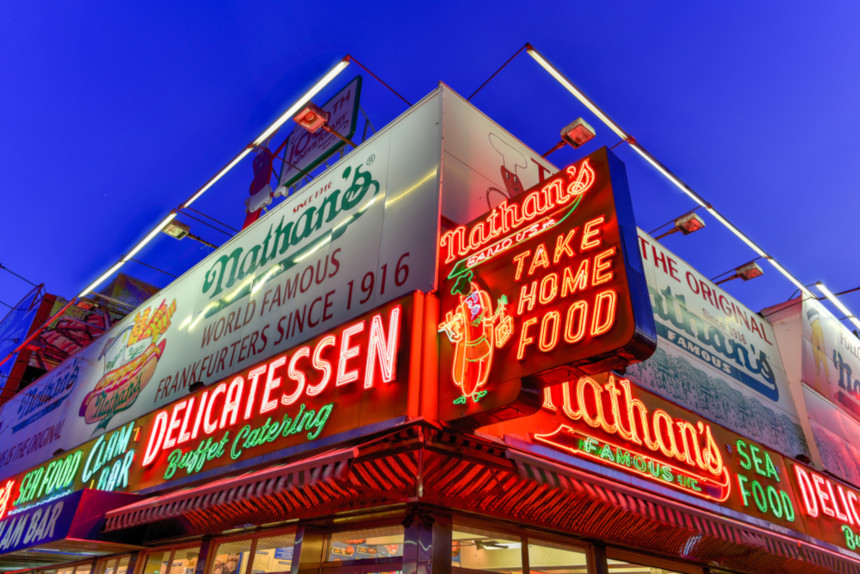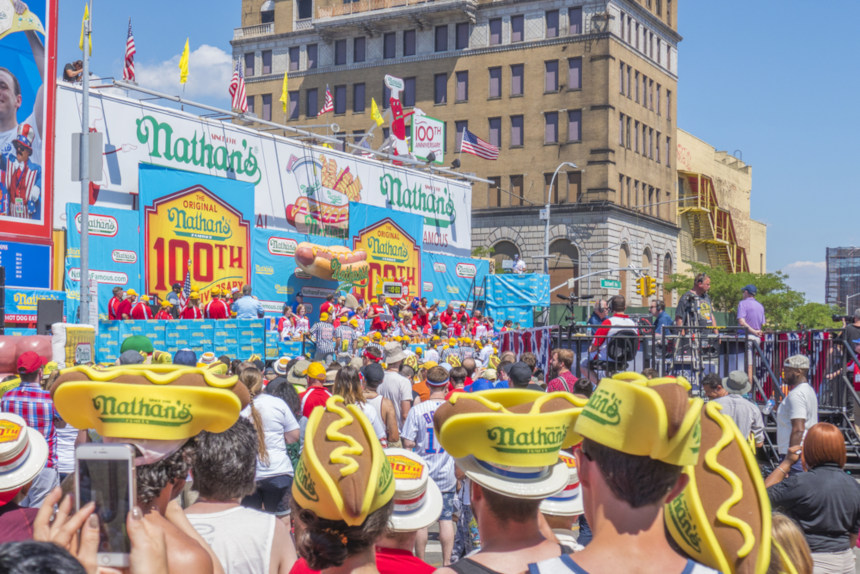The Dubious Past of the Annual Hot Dog Eating Contest
Traditions are grounded in history. Which is why the Coney Island Hot Dog Eating Contest fabricated its own history to be grounded in.
“Legend has it that on July 4, 1916, four immigrants gathered at the very first Nathan’s Famous hot dog stand in Coney Island and made eating contest history. … They were competing to see who was the most patriotic. How did they determine the winner? With a hot dog-eating contest, of course!” According to Nathan’s Famous hot dogs, this was the beginning of the annual contest’s rich American history. That must be it then. Whichever Irishman could eat the most frankfurters — an Austrian food, popularized by Poles, that takes its name from a German city — would be the most American.
Something just doesn’t add up.
ESPN retells story before the competition every year, but the contest and the hot dog itself have a false backstory used to associate them with America in order to sell more of the tube steaks. The first record of the most gluttonous sporting event of the year is from 1972, not 1916. Comparing the story that is told to what actually happened reveals how this famous cookout food took over American cuisine and how the contest became a tradition by convincing people that it already was one.
How the Hot Dog Became American
Nathan Handwerker, a Polish immigrant living in New York in the 1910s, worked at an “exotic” sausage restaurant in the unfinished Coney Island Resort under Charles Feltman, the man credited with bringing hot dogs — or wienerwurst as they were then called — to the States. In 1916, with $300 he borrowed from friends, Handwerker opened up his own unnamed wiener stand with a plan to undersell Feltman. He sold his hot dogs for 5 cents apiece — half of what Feltman was charging. Lower prices and a higher volume gave Handwerker the tools to pay back his loan in less than a month, and his brand has been on top ever since.
Being the cheapest hot dog in town attracted attention from the Brooklyn crowd, and attracting attention has been a part of the company’s identity ever since. Handwerker’s prices were so low that his competitors, including Feltman, accused him of making his all-beef hot dogs with other animals and even had some people wondering if there was more to the name “dachshund sausages” than just a silly piece of slang. The accusations attracted media attention, but as they say, all publicity is good publicity, and Handwerker played it up. He hired college students posing as doctors in lab coats to sit in the front of his stand and eat hot dogs, “authorizing” that his food was made with kosher, healthy meat. This stunt allowed him to gain the trust of the people of New York. It wasn’t much later that he named his restaurant Nathan’s Famous.

Over the years, New York hot dog culture permeated the nation, and the food became an American classic. Hot dog stands are cheap and easy to run, so they spread through the United States as a practical business. But no brand drove home this tie between Americans and hot dogs like Nathan’s Famous. Their marketing was reliant on this American pride to such a degree that in the 1970s, Nathan’s came up with the most American PR stunt imaginable: the hot dog eating contest, a gluttonous display of patriotism.
How the Contest Became a Phenomenon
In a 2010 New York Times interview, Morty Matz, an influential figure in the advertisement industry, admitted that, to sell more product, they had crafted the backstory about the contest starting in 1916 to make it look like a well-established American tradition. But Nathan’s legend didn’t stop at “four immigrants competed to see who was the most American.” Matz injected fictitious politics and controversy to make it more interesting and believable. Matz’s canon includes a contest cancellation in 1942 for World War II, as Brooklyn’s population was made up largely of European immigrants, as well as a cancellation in 1971 to protest Richard Nixon and the Vietnam War.
Nathan’s may have had an actual hot dog eating contest in 1967, as part of a celebration to mark the 100th anniversary of the hot dog coming to America. A few publications of the time recorded that the victor of the 1967 contest was Walter Paul, who was able to finish 127 sausages in an hour. (The current record is 74 hot dogs in 10 minutes.) However, it’s unclear whether Paul even existed.
The first recorded mention of the competition is in a 1972 article; this is most likely the first year the annual contest was actually held. But all these believable story threads wove together to create a “tradition” that had seemingly been around for decades.
Even after Matz’s exposure of the contest’s true origins, Americans continue to revel in the showcase of excess and sportsmanship. Every year, the contest attendance and ratings rise. The 2018 contest attracted over 40,000 attendees to watch Joey Chestnut break the hot dog-eating world record, and 2 million viewers tuned in to watch it on ESPN.

Aside from the money made from the contest’s ratings, the export hot dog industry pulls in over $15 billion a year for American companies because the world considers them to be the American-style sausage. Even in countries that have their own sausage delicacies, you can find a “New York Style” sausage at a restaurant and know exactly what to expect.
The Fourth of July contest has become a symbol of American culture through crafty and ethically dubious PR, but the results are anything but secret. Every year Americans consume 155 million of the “all-American” (but not-at-all-American) sausages. So, it’s no surprise that the industry uses the most American of holidays to promote its product.
Featured image: Library of Congress